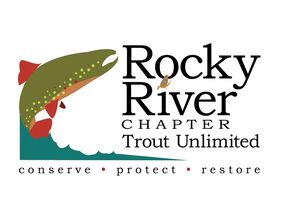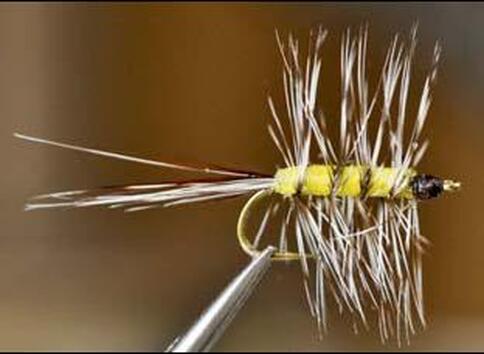Fly Of the Month 04.10
Yellow Palmer
One of the earliest mentions of a Palmer Fly was in Thomas Barker’s Art of Angling, published in 1651. Barker’s book discussed the flies of “greatest creddit” and explained the values of Palmer Flies. He contended they were more effective than the winged patterns, an opinion maintained by many experts today. Charles Cotton’s appendix to Isaak Walton’s fifth edition of The Compleat Angler (1675) contained a list of original fly patterns and differentiated between plain and palmered hackle-type flies. It was about this time that the soldier-palmer became well known, and so named because its solid red body resembled the color of the jackets worn by British Soldiers. Palmer is an old English name used to denote a caterpillar and the Soldier Palmer was tied to imitate the Palmer Worm or the hairy caterpillar of the tiger moth. The Yellow Palmer, along with the orange, is a very popular fly in the southern Appalachians and is it any wonder when you consider the earliest settlers to the area came form England in the 1700’s. This is an easy fly to tie and is suggestive of the little yellow stone fly, so common on our trout streams in late spring and early summer.
Fly of the Month 04.10 Yellow Palmer
Hook: Standard length and weight dry fly, Tiemco 100 or Mustad 94840, Size: 10, 12, 14
Thread: Uni 8/0 Lt Cahill
Tail: Traditionally blend of Brown and Grizzly hackle feathers.
Body: Yellow polyblend or Antron
Hackle: Brown/Grizzly hackle feather
Directions:
1) Start thread three or four eye lengths back from eye and wrap turn to turn to bend of hook ( over the hook point ).
2) Using six or eight hackle fibers tie in softly at hook bend forward to cover hackle and return thread to original hackle tie in point wrapping firmly but do not over pressure causing the tail to lift up. Tail should be straight and even.
3) Select a Brown & Grizzly hackle feather and strip the end of feather exposing about one eight inch of stem. Tie in stem, with the shiny side of the feather facing the eye, at the point where the tail is covered by thread and move out of the way.
4) Tie in Polyblend or Antron slightly forward of bend and wrap thread forward to about a third of the distance back from the eye to the hook bend. Let the bobbin and thread hang at this point and begin wrapping even and slightly overlapped turns of body material. You may use hackle pliers or tie by hand. When reaching the thread tie off the body material with three or four thread wraps and cut off extra material. Advance the thread to the eye and return with even wraps back to the forward point of the body material and let the bobbin and thread hang.
5) Begin to palmer the hackle by advancing forward in even and firm wraps to the point where the bobbin is hanging and tie the hackle off. Clip excess and finish the head with cement.
(An Orange Palmer can be tied using orange dubbing for the body and pheasant tippet for the tail.)
- Tom Adams, Tim Wilhelm
Yellow Palmer
One of the earliest mentions of a Palmer Fly was in Thomas Barker’s Art of Angling, published in 1651. Barker’s book discussed the flies of “greatest creddit” and explained the values of Palmer Flies. He contended they were more effective than the winged patterns, an opinion maintained by many experts today. Charles Cotton’s appendix to Isaak Walton’s fifth edition of The Compleat Angler (1675) contained a list of original fly patterns and differentiated between plain and palmered hackle-type flies. It was about this time that the soldier-palmer became well known, and so named because its solid red body resembled the color of the jackets worn by British Soldiers. Palmer is an old English name used to denote a caterpillar and the Soldier Palmer was tied to imitate the Palmer Worm or the hairy caterpillar of the tiger moth. The Yellow Palmer, along with the orange, is a very popular fly in the southern Appalachians and is it any wonder when you consider the earliest settlers to the area came form England in the 1700’s. This is an easy fly to tie and is suggestive of the little yellow stone fly, so common on our trout streams in late spring and early summer.
Fly of the Month 04.10 Yellow Palmer
Hook: Standard length and weight dry fly, Tiemco 100 or Mustad 94840, Size: 10, 12, 14
Thread: Uni 8/0 Lt Cahill
Tail: Traditionally blend of Brown and Grizzly hackle feathers.
Body: Yellow polyblend or Antron
Hackle: Brown/Grizzly hackle feather
Directions:
1) Start thread three or four eye lengths back from eye and wrap turn to turn to bend of hook ( over the hook point ).
2) Using six or eight hackle fibers tie in softly at hook bend forward to cover hackle and return thread to original hackle tie in point wrapping firmly but do not over pressure causing the tail to lift up. Tail should be straight and even.
3) Select a Brown & Grizzly hackle feather and strip the end of feather exposing about one eight inch of stem. Tie in stem, with the shiny side of the feather facing the eye, at the point where the tail is covered by thread and move out of the way.
4) Tie in Polyblend or Antron slightly forward of bend and wrap thread forward to about a third of the distance back from the eye to the hook bend. Let the bobbin and thread hang at this point and begin wrapping even and slightly overlapped turns of body material. You may use hackle pliers or tie by hand. When reaching the thread tie off the body material with three or four thread wraps and cut off extra material. Advance the thread to the eye and return with even wraps back to the forward point of the body material and let the bobbin and thread hang.
5) Begin to palmer the hackle by advancing forward in even and firm wraps to the point where the bobbin is hanging and tie the hackle off. Clip excess and finish the head with cement.
(An Orange Palmer can be tied using orange dubbing for the body and pheasant tippet for the tail.)
- Tom Adams, Tim Wilhelm

